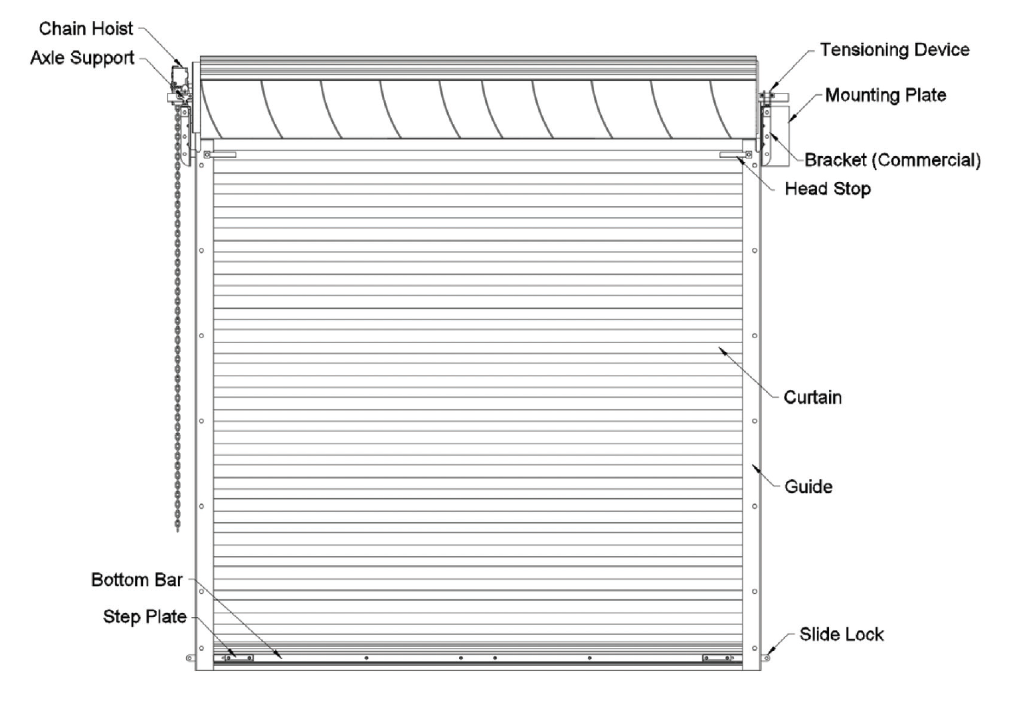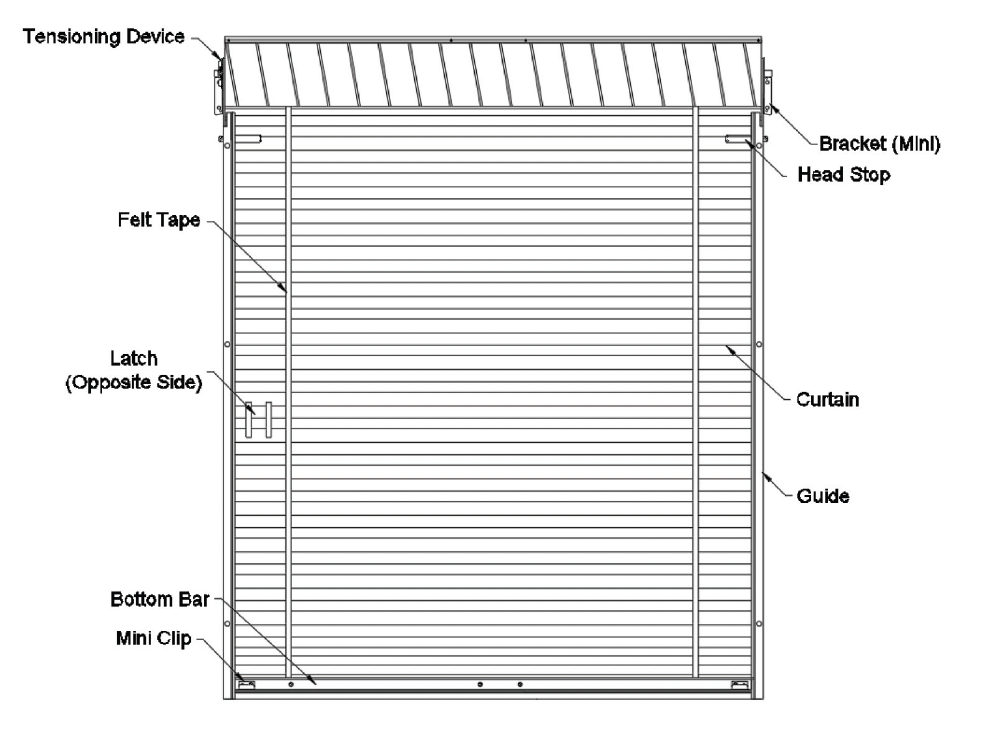Contact Us
Have questions about DBCI's products or services? Let us help.
The following manual is provided to evaluate the operational performance and future maintenance of DBCI Rolling Sheet door product line. DBCI mandates rolling sheet door product installation by trained rolling door technicians and future maintenance by experienced/qualied personnel. Specic parts, components, assemblies, etc. that are determined to be defective, worn, or unsafe by performance evaluations or preventative maintenance programs must result in rolling sheet door assembly taken out of service. All repairs, part replacements or adjustments must be made by trained rolling door technicians to place rolling sheet door assembly back into service. It is MANDATORY that all DBCI door technicians and other technicians, installers and future maintenance staff comply fully with all safety information, procedures, and instructions contained in this manual.
Failure to do so could result in premature part/component failure resulting in serious injury or death to others and, with respect to DBCI door technicians, immediate termination of employment.Rolling Sheet Door detail and Rolling Sheet Door Terminology is detailed on pages 2 – 7 of this manual. Please reference those pages for applicable terminology and visual reference.
Adjustments, part replacement, repairs, etc. must be performed by trained rolling door technician
WARNING: Extreme spring tension can cause serious injury or death
Close door using motor operator. Engage motors manual operation feature to manually operate the door to the open position.
If door operation is heavy, cannot be completely opened or hard to open and will not stay in open position; Spring Assembly counterbalance evaluation is required, which may require adjustment or replacement.
Spring tension adjustments or repairs must be made by trained rolling door technician. Refer to Rolling Door installation instructions for tension adjustment procedure.
Determination of counterbalance repair must result in Rolling Door taken out of service until required repairs are complete.
Determination of tensioning device repair or replacement must result in Rolling Door taken out of service until required repairs are complete. Repair or replacement must be performed by trained rolling door technician.
Product safety labels should be periodically inspected and cleaned by the product user as necessary to maintain good legibility for safe viewing distance
Product safety labels should be replaced by the product user when they no longer meet the legibility requirements for safe viewing distance. In any case where products have an extensive expected life or where exposed to extreme conditions, the product user should immediately contact DBCI to obtain replacements.
Axle Support — Component used to support and secure the axle to the bracket.
Bottom Bar — Reinforcing member at the lower edge of the bottom curtain panel.
Brackets — Support members above the top of the wall opening to which the axle assembly is attached.
Curtain — An assembly of curtain panels seamed together to form a single piece curtain.
Chain Hoist — Gear and gearbox assembly or Sprocket and roller chain assembly utilized in the safe operation of a door too large to operate manually.
Guides — Vertical assembly in which the curtain travels and that is fastened to the jamb, retaining the edges of the door curtain and closing the space between the curtain edges and the jamb.
Head Stops — Bars mounted at top of guides to prevent bottom bar from traveling out of the guides when the curtain is fully raised.
Hood Assy. — Assembled sheet metal components horizontally mounted over the coiled curtain and brackets, serving as a cover for the coiled curtain an closing door space between the door coil and the header. Hood assembly components are: Hood Endcaps, Hood, and Hood Support (when necessary).
Hood — A sheet metal housing that mounts to hood endcaps and wall horizontally over the coiled curtain and brackets, serving as a cover for the coiled curtain and closing the door space between the door coil and the header.
Hood Endcaps — Sheet metal components mounted to wall to serve as hood mounting structure as well as close off (Cap) end of hood to complete hood assembly.
Hood Support — “L” shape, steel channel, mounted to wall above and center of the opening to support a hood split into two sections in order to span full width of door assembly.
Latch — Locking device mounted to the exterior side of the curtain, which slides into a pre-existing slot in guide, and is used to secure curtain in the closed position. Equipped for padlock or cylinder lock.
Mini Clip — Plate installed on the bottom bar to prevent it from passing head stops when curtain is raised.
Mounting Plate — Steel plate used to install and support brackets when field conditions do not have adequate side room structure to mount brackets.
RDD-201, Tension Safety Label — Warns that when adjusting tension, death or serious injury could result. Instructs whom should make adjustments to spring tension and repairs as well as the position of the door while making adjustments & repairs. Label should be adhered to tension bracket, tension cover, or within 12” of components spring adjustment components and in clear view when door installation is complete.
RDD-202, Rolling Door Safety Label — Warns of the hazard of a moving rolling door. Door should not be placed in motion to closed position unless doorway is clear. Instructs of the safe operation of a rolling door. Label is to be placed at a readable height on the door drive side guide or jamb.
RDD-204, Rolling Door Bottom Bar Label — Similar language to RDD202, but installation location to bottom bar of rolling door assembly.
Side Draft Stop — Material attached to guides used to close gap between door curtain and the guide when the door is in the closed position. Predominately on insulated curtains.
Slide Lock — Locking device mounted to the interior side of the curtain at the ends of bottom bar angle, which slides into a pre-existing slot at bottom of guide. Equipped for padlocking.
Step Plates — Plate installed on the bottom bar used to push the door tight to the floor with foot when engaging locks, and also prevent bottom bar from passing head stops when curtain is raised.
Tensioning Device – A component attached to axle and bracket that controls the spring tension. Spring tension can be increased or decreased via this component.
Top Draft — Material attached to curtain used to close gap between door and header when door is in the closed position. Predominately on insulated curtains.
Wear Strip — Material attached to the curtain and guides to reduce paint wear and noise. Black nylon material-Guides, Black webbing material- Curtain (commercial), White felt tape-Curtain (mini).
Windbar — Angle mounted inside guide which engage windlocks under windload.
Windlock — A component which is attached at predetermined intervals to sheet ends to prevent curtain from leaving the guides under wind load, and which are sometimes used in conjunction with wind bars inside the guides.

